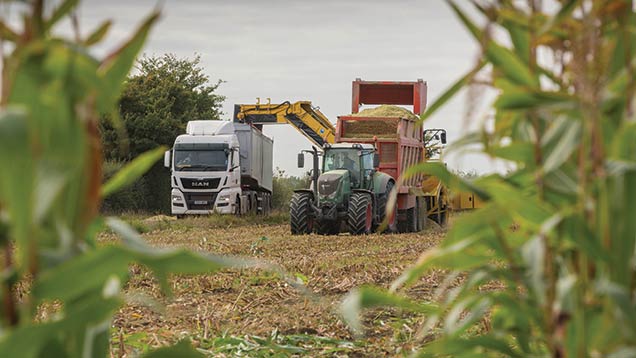AD feedstock must prove green credentials from autumn
 © Tim Scrivener
© Tim Scrivener Suppliers of crop-based feedstocks such as maize or grass silage to anaerobic digestion (AD) plants will have to meet strict new sustainability criteria from this autumn.
Operators could face hefty financial penalties from 5 October, when existing sustainability criteria for the Renewables Obligation (RO) will be extended to claimants of the Renewable Heat Incentive (RHI) and Contracts for Difference (CfD) support.
Any new or existing AD plant producing renewable heat via combined heat and power, or injecting biomethane to grid will be affected by the rules. Ofgem is due to publish draft guidance on the changes sometime this month.
What will it mean?
There are two main elements to the sustainability criteria, explains Lucy Hopwood, lead consultant for bioenergy and AD at bioeconomy consultant NNFCC.
See also: New biomass regulations will link reporting to payments for farmers
The first is that crops must not be grown on environmentally sensitive areas, such as peat land or primary forest. This does not have a significant effect on AD, other than plant operators confirming crops have not been grown on such land, but is of importance to woody biomass users, she says.
The second element is of more significance, as it requires all forms of renewable heat to deliver a 60% greenhouse gas (GHG) saving over fossil fuel, equivalent to maximum GHG emissions of 34.8g CO2 equivalent per MJ generated.
This covers GHG emissions through the entire supply chain, from crop cultivation, agronomy and harvest to ensiling, feedstock delivery to the digester and conversion into heat or biomethane.
“Because of the differing fossil comparator for heat and electricity, the target for heat generators is a lot tighter than the current RO limit of 79.2g CO2/MJ for electricity generators and there has been a lot of scaremongering about the government effectively banning crop-based AD. That is certainly not the case, but it is clamping down on unsustainable crops.
“Hopefully the implications won’t be too onerous, although it is likely to mean more administration for AD operators and changes to feedstock supply contracts.”
Meeting the targets
To comply with the new rules, operators of AD plants must submit GHG emissions data for every feedstock consignment on a quarterly basis (Ofgem is yet to accurately define a consignment).
Growers will have to provide information such as diesel use, pesticide and fertiliser applications, transport distances and crop yields for every feedstock consignment.
“Most data farmers have the ability to record relatively easily, or might already do so with farm management software,” says Mrs Hopwood.
A carbon calculator (B2C2) has been developed for Renewables Obligation sustainability reporting to help users calculate emissions, although it is complex to use, she says.
In a bid to ease the administrative burden on smaller-scale AD, operators with plants smaller than 1MW are being given the option to use default values for variables such as diesel use, yield and so on.
However, no crop-based feedstocks meet the required GHG saving using these default values, so operators effectively must submit actual data to comply with the rules, says Mrs Hopwood.
For example, NNFCC modelling using Ofgem’s default values for maize silage results in emissions of 45g CO2e/MJ, whereas using actual data puts most crops at 25-30g CO2e/MJ.
“Complying with the requirements is not an issue, but actual values have to be used,” says Mrs Hopwood.
The biggest sensitivities in the GHG calculation are nitrogen use (due to the potency of nitrous oxide), AD plant efficiency and crop yield. Generally biomethane gas-to-grid plants are more efficient than CHP, effectively diluting the feedstock emissions per MJ generated, she says.
“Yield is a key factor, especially given unpredictable weather. Potentially growers could do everything right growing the crop, but if poor weather reduces yields, emissions are spread over fewer tonnes and the consignment could exceed the GHG limit.
“Hopefully there will be flexibility and averaging-out of the figures, otherwise it will get too difficult to contract growers to supply feedstock. Ofgem are being pragmatic, liaising with industry and promise to take feedback on the draft guidance.”
What if crops miss the target?
AD operators will not be able to claim support payments on the proportion of heat/gas produced from any consignment that fails to meet the required GHG saving, so anyone supplying feedstocks on contract will be under pressure to deliver crops that meet the criteria.
How this affects feedstock supply contracts will vary between AD operators, and some may include grower protocols limiting fertiliser applications or specifying cultivation methods to use, Mrs Hopwood suggests.
See also: More details on the new rules for AD
“Any nitrogen limits should be within standard agronomic practice for most growers, though.”
Financial penalty clauses could also be used in contracts in the event a feedstock fails to meet the criteria as AD operators seek to cover themselves for potential loss of support income.
“Growers will have to look very carefully at supply contracts and be confident they can produce crops to meet those requirements, as well as supply the information required.”
Mrs Hopwood believes it is inevitable sustainability criteria will be built into the Feed-in Tariff scheme when it is reviewed this year, with changes taking effect next April.

